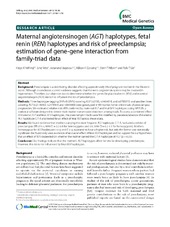| dc.description.abstract | Background Preeclampsia is a debilitating disorder affecting approximately 3% of pregnant women in the Western world. Although inconclusive, current evidence suggests that the renin-angiotensin system may be involved in hypertension. Therefore, our objective was to determine whether the genes for placental renin (REN) and maternal angiotensinogen (AGT) interact to influence the risk of preeclampsia. Methods Three haplotype-tagging SNPs (htSNPs) covering REN (rs5705, rs1464818, and rs3795575) and another three covering AGT (rs2148582, rs2478545 and rs943580) were genotyped in 99 mother-father-child triads of preeclampsia pregnancies. We estimated relative risks (RR) conferred by maternal AGT and fetal REN haplotypes using HAPLIN, a statistical software designed to detect multi-marker transmission distortion among triads. To assess a combined effect of maternal AGT and fetal REN haplotypes, the preeclamptic triads were first stratified by presence/absence of maternal AGT haplotype C-T-A and tested for an effect of fetal REN across these strata. Results We found evidence that mothers carrying the most frequent AGT haplotype, C-T-A, had a reduced risk of preeclampsia (RR of 0.4, 95% CI = 0.2-0.8 for heterozygotes and 0.6, 95% CI = 0.2-1.5 for homozygotes). Mothers homozygous for AGT haplotypes t-c-g and C-c-g appeared to have a higher risk, but only the former was statistically significant. We found only weak evidence of an overall effect of fetal REN haplotypes and no support for our hypothesis that an effect of REN depended on whether the mother carried the C-T-A haplotype of AGT (p = 0.33). Conclusion Our findings indicate that the mother's AGT haplotypes affect her risk for developing preeclampsia. However, this risk is not influenced by fetal REN haplotypes. | en_US |

